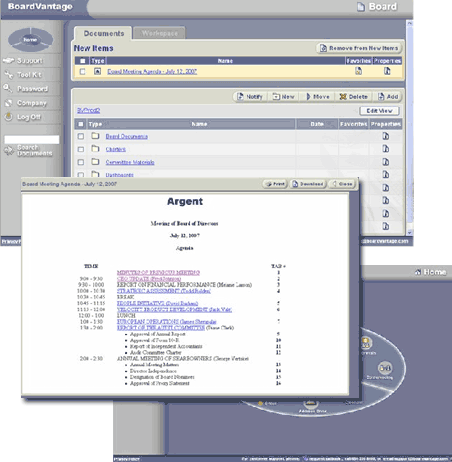
 Information Architecture Challenge: Information Architecture Challenge:
Map workflows and improve the navigational model for both current users (information publishers) and prospective users (information consumers & information feeds) for a secure hosted web portal for Fortune 500 Board of Directors. Access to board was extremely rare and very guarded, so user research presented a unique challenge.
The user experience was perceived as simple by stake-holders but actual user adoption was low. This was due in large part to not anticipating users needs. Lack of familiarity with UCD methodologies led them to believe they could not determine common workflows. Screens often contained too little information to keep them "simple" and workflows did not anticipate next most likely tasks. This resulted in the user taking just too many clicks in order to achieve their goals.
 Solution: Solution:
We determined navigation was the top pain point. To a simplify the navigational model:
- Created multiple user personas based on the most common types of BoardVantage users (Corporate Secretary, Office of the Corporate Secretary, General Counsel, corporate management, board member, board committee member, etc.)
- Conducted user research to create user scenarios and user personas.
- Created workflow and screen flow analysis with Visio
- Introduced "permalinks:" the ability to go to a specific space or document from a hypertext link.
- Encouraged "best practices" where as a service we assist the customer to set up their workspace and workflows to be less cumbersome.
 User Experience Challenge: User Experience Challenge:
Design the user experience of a hosted private, secure information-sharing web application for Fortune 500 Board of Directors. Improve the overall user experience for current users and prospective users for a secure hosted web portal for Fortune 500 Board of Directors.
The current users were mostly information publishers within corporations (Office of the Corporate Secretary and General Counsel). Prospective users were information consumers and information producers. Information consumers were corporate governance outside the corporations (the board members), while information producers (typically executive officers and their staffs) were inside the corporation yet neither responsible for publishing nor privileged to board materials, instead they were responsible for producing material the information publishers used as a piece of the board materials. Access to all board members is extremely very guarded, so user research presented a unique challenge.
 Solution: Solution:
Using the workflow and screen flow analysis, we determined the application needed streamlined workflows. Used iterative design and usability testing to refine screens and screen flows to improve known workflows. Since access to customers was highly guarded conducted user research by interviewing customer-facing staff starting with customer support as well as the CEO, CTO, VPs of Product Management, Marketing, Security and Account Management. Utilized the emerging best practices as another source. Listened to customer calls when permitted. User research revealed common workflows and procedures.
Used iterative designs and usability testing to refine screens and screen flows for these workflows:
- Reduced screen counts on most workflows by over 50%
- Consolidated screens which were most likely to be seen only internally or by power users (such as address book entry creation)
- Increased contrast and font size (most Board members are over 60 and may have poor eyesight)
User research also revealed a desire by board members for collaboration. Introduced a simple and secure method for online collaboration via annotation of board materials.
 Visual Design Challenge: Visual Design Challenge:
Design the look and feel for a hosted private, secure information-sharing web application for Fortune 500 Board of Directors. The application needs to be easy to use for infrequent users of the system.
 Solution: Solution:
Using the navigational model, we determined the application a consistency of visual elements
since it needs:
- a highly refined visual design
- visual clues to the location
- queues to common elements such as links to other sections
The user experience could not deviate substantially from common web experience since the user too infrequent to learn the interface, so any metaphor must be readily understandable. The location of navigation elements such a locators and links must be consistent for the same reason and to convey higher quality (consistency is a trademark of quality).
Client: BoardVantage, Inc.
Application: Board Work Portal
Users: Office of the Corporate Secretary (Executives Officers, General Counsel, and Executive Assistants), Board of Directors
Usage: Almost no users are unlikely to use this system on a daily basis. Board members will only access it once a quarter at most, possibly never as many preferred to get the materials delivered after printing.
|